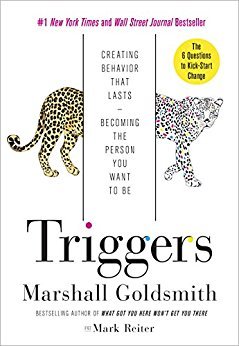More on this book
Community
Kindle Notes & Highlights
Read between
March 11, 2018 - February 12, 2023
It’s why some obese people finally—and instantly—take charge of their eating habits when they’re told that they have diabetes and will die or go blind or lose a limb if they don’t make a serious lifestyle change. Death, blindness, and amputation are consequences we understand and can’t brush aside.
Owners of hybrid cars (like me in my Ford C-Max) are in a feedback loop when they obsessively check their dashboard’s gas consumption display and adjust their driving to maximize gas mileage (they’re called “hypermilers”).
Where a well-designed feedback loop triggers desirable behavior, our environment often triggers bad behavior, and it does so against our will and better judgment and without our awareness. We don’t know we’ve changed.
A behavioral trigger is any stimulus that impacts our behavior.
1. A behavioral trigger can be direct or indirect.
2. A trigger can be internal or external.
inexplicably
3. A trigger can be conscious or unconscious.
4. A trigger can be anticipated or unexpected.
raucous
We know that our demeaning language will trigger other people’s anger so we avoid it.)
5. A trigger can be encouraging or discouraging.
A trigger can be productive or counterproductive.
“smothering”
Equal levels of devotion and caring can trigger gratitude in one child and rebellion in another. Same parents. Same triggers. Different responses.
it’s helpful to take a closer look at these last two dimensions of triggers—encouraging or discouraging, productive or counterproductive. They express the timeless tension between what we want and what we need. We wan...
This highlight has been truncated due to consecutive passage length restrictions.
Unfortunately, what we want often lures us away from what we need.
Pain, of course, is the ultimate discouraging trigger: we immediately stop a behavior that hurts.
dead-end situations that make us miserable—and we can’t see any way out of them. It could be a toxic workplace or a violent neighborhood, the kinds of environment that trigger unhealthy behavior steering us away from our goals.
There’s not much mystery to why these ugly environments trigger fatigue, stress, apathy, hopelessness, isolation, and anger. The only puzzle is why we choose to stay here instead of fleeing at high speed.
a trigger is a problem only if my response to it creates a problem.
We always have a choice. That’s not so clear-cut when the subject is triggers and our response to them.
the classic sequencing template for analyzing problem behavior in children was known as ABC, for antecedent, behavior, and consequence.
In his engaging book, The Power of Habit, Charles Duhigg applied this ABC template to breaking and forming habits. Instead of antecedent, behavior, and consequence, he used the terms cue, routine, and reward to describe the three-part sequence known as a habit loop.
Duhigg’s Golden Rule of Habit Change—keep the cue and reward, change the routine—but
when we’re changing interpersonal behavior, we’re adding a layer of complexity in the form of other people. Our triggered response can’t always be automatic and unthinking and habitual—because as caring human beings we have to consider how people will respond to our actions.
I’d like to propose a modification to the sequence of antecedent, behavior, and consequence—by interrupting it with a sense of awareness and an infinitesimal stoppage of time.
Paradoxically, the big moments—packed with triggers, stress, raw emotions, high stakes, and thus high potential for disaster—are easy to handle. When successful people know it’s showtime, they prepare to put on a show. It’s the little moments that trigger some of our most outsized and unproductive responses: The slow line at the coffee shop, the second cousin who asks why you’re still single, the neighbor who doesn’t pick up after his dog,
These are life’s paper cuts.
Paul’s most durable contribution to the field of organizational behavior was a concept he called “situational leadership.” He developed it with my friend and hero, Ken Blanchard.
1. Directing
Coaching
Supporting
Delegating
The least effective leaders never get it. They’re the ones who tell a talkative subordinate, “You need to be a better listener” and expect that one-time conversation to make a lasting impression. They don’t see the irony in telling a bad listener to be a better listener and then being surprised that the subordinate didn’t listen.
Measure Your Need, Choose Your Style
we start each day as a bifurcated individual, one part leader, the other part follower—and as the day progresses, the two grow further apart.
You still have to deal with an environment that is more hostile than supportive. You still have to face other people who tempt you away from your objectives. You still have to factor in the high probability of low-probability events. And you still have to consider that as the day goes on and your energy level diminishes, your motivation and self-discipline will flag.
how we manage others is how we should manage ourselves—with
Let’s use the term planner for the part of us that intends to change our behavior and doer for the part of us that actually makes change happen. The disconnect is the same: We are superior planners and inferior doers.
Our failure to do what we plan is a certainty like death and taxes.
prod,
swaddled
convivial
The boxer-philosopher Mike Tyson said, “Everyone has a plan until they get punched in the face.” As we wander through life, what punches us in the face repeatedly is our environment.
The 1949 film Twelve O’Clock High is nearly forgotten now, but it is still much admired in business schools as a step-by-step illustration of situational leadership.
trim.
I can always identify the neighbors who are fanatical sailors, surfers, or golfers. They’re the ones checking their phones for hourly weather updates.
They are not only aware of the environment, they go out of their way to forecast it.


